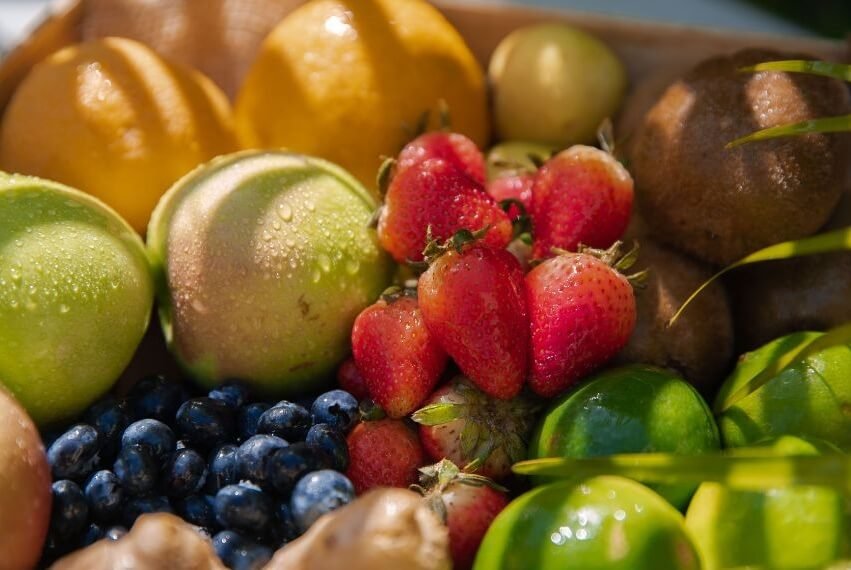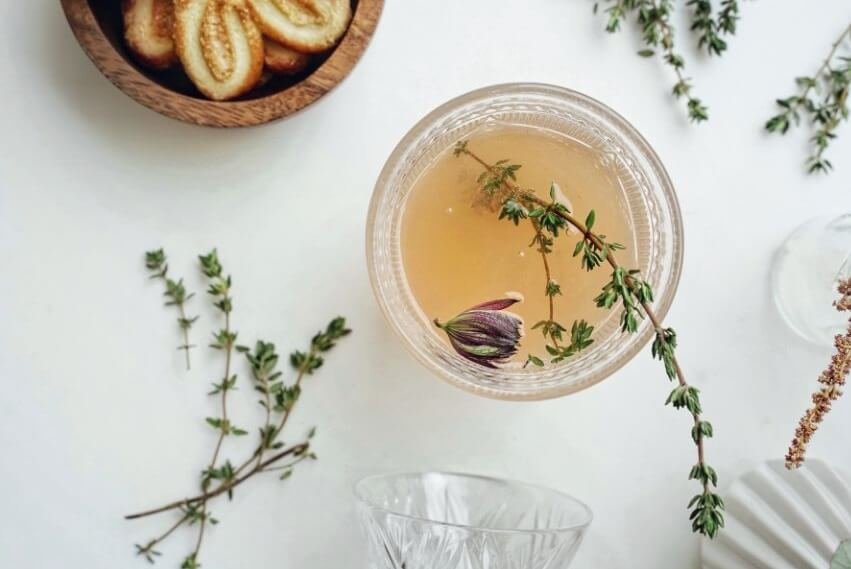
Mead, often referred to as “honey wine,” is an ancient alcoholic beverage made from fermenting honey with water and sometimes fruits, spices, or herbs.
While traditional mead has a delightful honey flavor, you can enhance and customize its taste by adding different ingredients.
When you already made a couple of traditional mead batches, you’ll want to experiment and go beyond the simple honey-based flavors the traditional mead is known for.
In this guide, we’ll explore various methods to add flavor to mead, taking it beyond its standard profile and creating a delightful beverage that suits your palate.
Exploring Flavoring Options
Using Fruits in Mead
Adding fruits to mead can create a delightful blend of flavors. Popular choices include berries, apples, peaches, and citrus fruits.
Bear in mind that these are just some popular choices, you can add almost any fruit you have in your mind.
It’s just important to know the characteristics of the fruit and its pairing with the honey and possible issues it could bring such as high tannins, water content, and a large amount of sugar that will produce unwanted alcohol or cloudiness that comes from pectin found in fruits such as apples, peaches, and apricots.
What’s beautiful with late fruit additions is that you can experiment and find a mix of your favorite fruit with your favorite honey and make a truly unique mead.
This is possible because there are so many possible combinations when it comes to mixing fruits and honey.
Soon you’ll be able to find a whole guide dedicated to using fruits in mead on this website as this topic requires a detailed article.

Enhancing with Spices and Herbs
Spices like cinnamon, cloves, and nutmeg, along with herbs like rosemary or mint, can infuse mead with unique and aromatic tastes.
Some honey will fit better with certain spices than others, but lots of it is very subjective, so you’ll need to do a few tests to determine what satisfies your palate.
Incorporating Botanicals and Flowers
Botanicals and flowers like lavender, chamomile, and hibiscus can lend floral notes and complexity to your mead.
You can enhance the existing characteristics of honey such as by adding more lavender to lavender honey which is my favorite way of adding flowers.
However, experimentation always works, just ask yourself questions such as would you like the aroma of lavender in buckwheat honey?

Considering Different Types of Honey
Different varieties of honey, such as wildflower, orange blossom, or buckwheat, can significantly impact the flavor profile of your mead.
We explained more about the various types of honey used in mead-making.
Without good honey as a baseline, it’s difficult to create a tasty mead.
Complementing vs. Overpowering
When flavoring mead, it’s crucial to consider how each ingredient will interact with the honey’s base flavor.
For example, the delicate floral aroma of lavender can complement the floral undertones of certain honey, while the warm spice of cinnamon can enhance the sweetness of honey.
On the other hand, overpowering flavors can mask the subtleties of honey and lead to an unbalanced and overwhelming taste.
For instance, using too much citrus zest may overshadow the gentle sweetness of honey and result in a sharp and citrus-dominated mead.
Tasting Tips
To begin with experimentation, I always make a big batch of traditional mead and then transfer it into bottles or a secondary fermenter with flavoring additions.
When it comes to fruits, it’s recommended to leave mead in a secondary fermenter with fruit additions for 2-4 weeks.
It’s also suggested to soak herbs, spices, and flowers with vodka overnight and add a small sample to each bottle when bottling mead.
It will take at least a few days before the flavors blend together, but this is a quick way of determining multiple flavoring options. (The alcohol in vodka kills bacteria and wild yeast).
You should do the following in the process of determining your winner.
- Keep a Tasting Journal: Maintain a record of your mead-making process, including the types and quantities of flavorings used. This journal will help you track the development of flavors and serve as a reference for future batches.
- Take Notes: Record your observations after each tasting session. Describe the flavors, aromas, and any changes you notice over time. This practice will help you fine-tune your flavoring techniques and achieve consistency in your mead.
- Use Small Samples: When tasting, use small samples to avoid overwhelming your taste buds. Take note of the initial impression, aftertaste, and how the flavors evolve as the mead ages. You can use water to refresh your buds for another sample.
- Experiment with Blending: If you find that a particular flavoring is too dominant, consider blending the flavored mead with unflavored mead in different ratios. This blending technique can help balance out the flavors and create a more nuanced taste profile.
Remember, patience and thoughtful experimentation will lead you to discover your signature mead creations that delight both your senses and those of your fortunate guests.
Mead Recipe Ideas for Inspiration
I’ll give you a couple of ideas for making your meads more interesting by playing with the flavors. Don’t follow me word for word or ingredient for an ingredient, these are ideas straight out of my head and the recipes might need some tweaking.
I’ll create recipes and post them on this website but first need to try what works the best! Until then, use the following recipe ideas for your own experiments, and feel free to adjust anything according to what makes sense to you!
The following recipe ideas will work for a 5-gallon batch, but you can make the 1-gallon batches or less by simply adjusting the amounts of ingredients to your liking.
For instance, 15 lbs of honey for a 5-gallon batch will result in a strong (around 13-14% ABV) mead, so add 3 lbs for only a gallon of mead to keep it the same strength.
Similarly, adjust other ingredients, so instead of 3 cinnamon sticks add between 1/2 to 1 per gallon or so.
1. Spiced Apple Cider Mead
Ingredients:
- 15 lbs of honey
- 4 gallons of water
- 1 gallon of apple cider
- 3 cinnamon sticks
- 1 tablespoon of whole cloves
- Champagne yeast
You can stir the apple cider, cinnamon sticks, and cloves and add them to the must for primary fermentation.
2. Berry Burst Mead
Ingredients:
- 15 lbs of honey
- 4 gallons of water
- 5 lbs of mixed frozen berries (strawberries, blueberries, raspberries)
- 1 packet of wine yeast
Simply add the berries once the mead is complete in the secondary, and while you can also add the berries in the primary I’d bring them to a quick boil first to kill possible wild yeast or bacteria.
Bear in mind the frozen berries will release extra water.
3. Elderberry and Rose Petal Mead
Ingredients:
- 15 lbs of wildflower honey
- 5 gallons of water
- 2 cups of fresh elderberries
- 1 cup of dried rose petals
- 1 vanilla bean, split
- Wine yeast
You can soak rose petals and vanilla beans in vodka for a couple of days to extract most flavors, then add it later once the mead is completely fermented.
You can add elderberries prior to that in the primary or secondary.
4. Ginger and Lemon Zest Mead
Ingredients:
- 15 lbs of clover honey
- 5 gallons of water
- 2 cups of fresh ginger, peeled and grated
- Zest of 4 lemons
- 1 cinnamon stick
- Champagne yeast
Ginger goes so well in combination with lemons and cinnamon and the clover honey is the perfect base.
I’d add crush the ingredients and soak them in vodka for a couple of days prior to adding them to the secondary or finished mead prior to bottling.
5. Cherry Vanilla Mead
Ingredients:
- 15 lbs of orange blossom honey
- 5 gallons of water
- 5 cups of fresh or frozen cherries, pitted
- 2 vanilla beans, split
- 1 teaspoon of almond extract
- Wine yeast
Make traditional blossom honey mead and later add cherries in a secondary. You can soak vanilla beans in vodka for a couple of days and add them to your tasting prior to bottling.
6. Spiced Pumpkin Mead
Ingredients:
- 15 lbs of wildflower honey
- 5 gallons of water
- 1 cup of pumpkin puree
- 2 cinnamon sticks
- 1 teaspoon of ground cloves
- 1/2 teaspoon of ground nutmeg
- Wine yeast
I’d add the pumpkin mixture in the secondary.
Stir it on the heat for 20-30 minutes along with other ingredients and some water to make the roast flavors and sanitize it.
Make traditional wildflower honey mead and once you add this mixture in the secondary it should do wonders.
Age and Bottling Considerations
Proper Aging of Flavored Mead
The aging process is essential for mead, especially the flavored variations. Aging allows the flavors to blend and mellow, resulting in a smoother and more refined taste.
Depending on the recipe and your preference, mead can age from several months to several years.
However, the stronger the mead, the longer aging is required.
While it’s common for home mead makers to hurry out of excitement and finish all their bottles before they had time to age, you should try to control yourself as it’s worth it!
Tip: if you can’t wait for mead to fully age, stash a few bottles somewhere in the dark corner where you won’t be entering every day, forget about them for a year and you’ll be surprised.
Carbonation Options
If you prefer fizzy mead, there are two primary carbonation methods – natural carbonation and force carbonation. For natural carbonation, add a measured amount of sugar to the mead before bottling, allowing the yeast to produce carbon dioxide. For force carbonation, use a carbonation system to add carbon dioxide directly to the mead.
The natural method is cheaper but it’s also more difficult to achieve, and this is especially the case when you want your mead to be both sweat and carbonated (just as it’s the case with ciders).
Force carbonation is the way to go once you get experienced and decide to invest in equipment.
Serving and Pairing Mead
The Right Temperature
The ideal serving temperature for mead varies depending on the type and flavor profile. In general, traditional meads are best served slightly chilled, while the lighter and fruity variations are more refreshing when served cold.
Food Pairings for Mead
Mead’s diverse flavors make it an excellent pairing with various dishes. It complements cheese platters, roasted meats, spicy foods, and desserts like cakes and pastries. Experiment with different pairings to find your perfect match.
Conclusion
Adding flavor to mead opens up a world of possibilities for creating unique and delicious variations of this ancient beverage. From fruits and spices to herbs and botanicals, the choices are endless.
Remember to start with quality ingredients, maintain proper sanitation, and be patient during the aging process.
With a little experimentation and creativity, you can craft meads that are tailor-made to satisfy your taste buds.
Just don’t forget to write down the progress, observations, and experiments you make in a notebook!
FAQs
Is mead gluten-free?
Yes, mead is naturally gluten-free as it’s made from honey and does not contain grains.
How long does it take to make mead?
The time it takes to make mead varies depending on the recipe and fermentation process. On average, it takes around 4-6 weeks, but aging can take several months to years.
Can I use frozen fruits in mead-making?
Yes, frozen fruits can be used in mead-making. They offer convenience and are often available year-round.
What is the ideal alcohol content for mead?
Mead typically has an alcohol content ranging from 8% to 20% ABV (alcohol by volume), but it can vary depending on the recipe and fermentation process. The ideal alcohol content for mead is whatever you like.
How long can I store flavored mead?
Properly stored, flavored mead can age gracefully for several years, with some varieties improving in taste over time. However, it’s best to consume it within 2-5 years to enjoy its vibrant flavors. It’s also important to notice that if at any stage the oxygen was introduced into mead after fermentation, it will over time affect the flavors.
